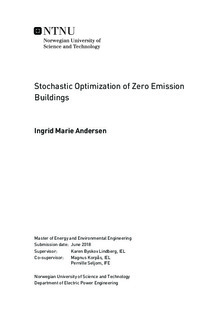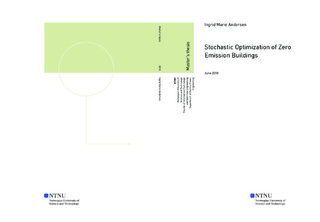| dc.description.abstract | Zero Emission Buildings (ZEBs) are energy efficient buildings that produce on-site
renewable energy to compensate for their consumption. The concept of ZEBs is
based the EU's Energy Performance of Buildings Directive (EPBD) of 2010,
demanding that all new buildings constructed after 2020 are to reach "near zero
energy level. Previous research on energy systems in ZEBs have used deterministic
linear optimization techniques to determine the cost-optimal design of invested
technologies in such sustainable buildings.
The main contribution of this thesis is the development of a stochastic two-stage
model, formulated as a Mixed Integer Linear Program (MILP), that determines the
cost-optimal investments and operations of a ZEB. The model accounts for
uncertainty in the short-term operational patterns; the fluctuations in the outdoor
temperature, the spot price of electricity and solar irradiation. The two the main
objectives are: 1) To compare the optimal technology design of the deterministic and
stochastic model counterparts and 2) to investigate the possibilities of the investment
of an electric battery. Emissions constraints are formulated to fit the ambition level
known as the "ZEB-O" level, only considering emissions caused in building
operations.
The model input data is simulated to fit the hourly demand of electricity and heating
in a Norwegian passive house. Time series on simulated demand from 2010 to 2014
are used to construct operational scenarios. Realistic investment costs of building
technologies are used based on an extensive survey of Norwegian manufacturers'
prices. Clustering analysis is used to reduce the computational effort by selecting
seasonally representative hours to imitate a full year of operations.
Results show that a stochastic model can better, than its deterministic counterpart,
account for the following: (i) Cover the peak heat demand of periods colder than the
deterministic input data, and (ii) avoid over-dimensioning of the installed base-load
capacity. The net present value of the total costs can be reduced by 1/6, which
represents the quantitative value of using a stochastic model in the place of a
deterministic model. Furthermore, the stochastic model is used to analyze the impact
of a "power subscription" grid tariff scheme and battery operations in ZEBs. The
battery is not a cost-optimal technology in ZEBs due to the forced reinvestments
every 10th year imposed by the stochastic two-stage formulation. Sensitivity analysis
show that the battery specific investment costs (EUR/kWh of storage capacity) must
be reduced by 90 \% to become part of the solution. | |

